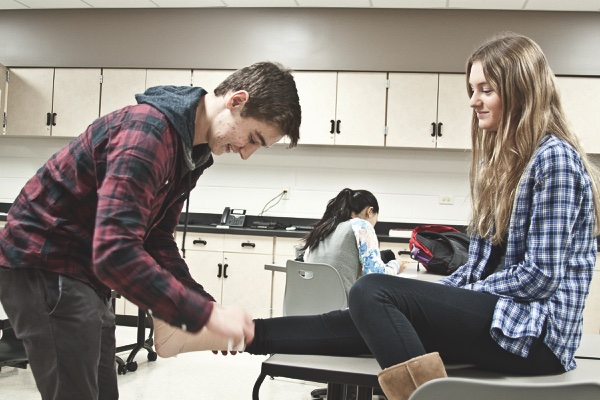At Huntley High School, education is being transformed by innovative teachers and 15-year-old freshmen who are not afraid to think way outside of the box.
Take a look at a part of the new curriculum in science, and you find courses in medical skills and services, physical therapy, first responder skills, sports medicine, medical ethics, fire science, medical interventions, and biological forensics.

Junior Eric Maurer tapes senior Brooke Schlotman’s ankle for a demonstration in HHS’s sports medicine class.
Starting next fall, seniors committed to careers in the healthcare field will have opportunities to job shadow at a local hospital with healthcare professionals, similar to the way medical residencies are conducted in universities and medical schools.
This is HHS’s Medical Academy, a five-year-old innovative educational project that has developed from a suggestion made back in 2011 by a math teacher and athletic trainer. Renae St. Clair wanted to use her athletic training studies in college to develop high school classes in sports medicine and medical skills.
“Dr. John Burkey, our superintendent, liked the idea so much he suggested that it be not just one class, but an academy with lots of class options,” said Shelly Kish, associate principal of curriculum, instruction, and assessments at HHS. “We launched the first classes in the 2011-12 academic year, and the project has been enthusiastically embraced by hundreds of students at all levels, from freshmen to seniors.”
A brochure developed to promote the program among Huntley’s 2,700 students puts it this way: “The HHS Medical Academy is an opportunity for students to take classes with a medical theme. Getting accepted into the academy does not commit students to anything. It gives them opportunities to focus on their futures and take additional medical themed classes. The academy is for students who know they would like a future in a medical profession, but it is also for students who aren’t sure. Several classes include career exploration where they might find out about medical careers that they didn’t know existed.”
To qualify, students must have an above-average grade point average, submit statements about their career plans, and make presentations on their accomplishments.
The bottom line is this: the academy jump-starts a young person’s career planning much earlier than in traditional secondary education, and gives graduating seniors a much stronger and fuller understanding of their career options and opportunities when they enter higher education. “Students learn that the healthcare field isn’t just doctors and nurses, it about more than 200 healthcare professions in a field that is growing fast to keep up with America’s aging society,” said St. Clair.
”The first class we created was medical skills and services, and today we have about 25 medically themed classes,” said Kish. They range from the original medical skills to physical therapy, medical Spanish, sports medicine I and II, medical English, fire science, advanced placement biology and chemistry, biomedical sciences, medical interventions, biological and physical forensics, microbiology, and advanced anatomy and physiology.
The Sun Day visited an academy class in biomedical science recently. Several small teams of seniors worked in groups creating research and analysis projects. Instructor Jeff Robinson, a science teacher, did not lecture or lead a class discussion. The students worked independently, using Robinson as a resource person to give advice or answer specific questions.
“I function as sort of a guide, monitoring their activities and being available to help them solve problems,” Robinson said.
At one table, three young women, all seniors, examined an eyesight evaluation chart like the ones we all are asked to read in physician’s offices.
“We plan to test visual acuity and how it is affected by changes from light to darkness,” said Sanjana Sivakumar, who said she wants to be a surgeon.
“We plan to ask some of our fellow students to be subjects of our research,” said Nicole Zielinski, who said she plans enter the medical research or surgical fields.
“I plan to be a physical therapist,” said Sarah Henderson. “We are all committed to the study and practice of medicine, and this is a great way to check out our options.”
In a nearby classroom, teacher Lana Johnson taught a medical English class, using a book about a woman whose cells were used in cancer research. “These students want to use non-fiction literature to study medicine from a human and compassion perspective,” said Lana Johnson, English teacher.
In Ms. St. Clair’s classroom, the students learn about medical terminology, anatomy, taking vital signs, athletic training, and first responder skills and services.
“I teach students about the skills they will need across a range of healthcare areas,” St. Clair said. “Here, we open the doors to more than 200 possible healthcare-related careers. The education required in medicine varies from taking one class for one semester and becoming certified, all the way up to specialties that require more than 12 years of post-secondary schooling.” Some of the classes are taught at McHenry County College, another partner with the high school in the academy project.
Kish, who oversees all academic and curricular matters at HHS, said she is part of a team that is now discussing the job shadowing possibilities with Centegra Healthcare, which plans to open a state-of-the-art full-service 118-bed hospital in Huntley next year.
“This job shadowing came up last year, and Centegra has agreed to partner with us. This will enable students to get a first-hand look at how medicine in a hospital setting really works. Huntley High School has the largest medical academy in the state of Illinois, with more than 700 students participating, and the number is growing,” Kish said. “We are seeing an exciting innovation come true.”





8 Comments
To the mysundaynews.com administrator, Thanks for the well-researched post!
Hi mysundaynews.com owner, You always provide key takeaways and summaries.
To the mysundaynews.com administrator, Your posts are always well researched and well written.
Dear mysundaynews.com admin, Your posts are always on topic and relevant.
Hi mysundaynews.com webmaster, Your posts are always interesting.
Dear mysundaynews.com admin, Good job!
Hello mysundaynews.com webmaster, You always provide great information and insights.
Hi mysundaynews.com administrator, Thanks for the educational content!